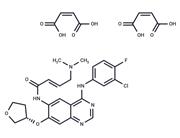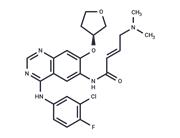| Name | (S)-Afatinib |
| Description | (S)-Afatinib (BIBW2992) is an irreversible EGFR family inhibitor with IC50s of 0.5/0.4/10/14/1 nM for EGFRwt, EGFR (L858R), EGFR (L858R/T790M), HER2, and HER4, respectively. |
| Cell Research | Cells (1×10^4) were transferred into each well of a 96-well plate and cultured over night in serum-free media for EGFR phosphorylation assay. After addition of test compounds on the next day, the plates were then incubated at 37°C for 1 hour. EGF-stimulation was done at 100 ng/ml for 10 min at room temperature. Cells were washed with ice cold PBS before extraction with 120 μl per well HEPEX buffer and shaken for 1 h at room temperature. In all 2×10^4 cells per well was used for HER2 phosphorylation assay. Streptavidin precoated plates were coated with anti-EGFR-biotin at 1:100 dilution with blocking buffer and c-erb2/HER2 oncoprotein Ab-5(Clone N24)-Biotin. Extracts from above steps were then transferred to the antibody-coated wells and incubated for 1 h at room temperature. Assessment of color development is described in Supplementary information. Extinction was measured at 450 nm. The data generated were analysed by the program PRISM. Normalized values were used to calculate the IC50 by a nonlinear regression curve fit (variable slope) [1]. |
| Kinase Assay | The wild type tyrosine kinase domain of the human EGFR, as well as the EGFR L858R/T790M double mutant, were fused to Glutathione-S-transferase (GST) and extracted as described in Supplementary methods. The L858R mutant was purchased from Upstate. Enzyme activity was then assayed in the presence or absence of serial inhibitor dilutions performed in 50% Me2SO. A random polymer pEY (4:1) from Sigma was used as substrate. Biotinylated pEY was added as a tracer substrate. The kinase domain of HER2 was cloned using baculovirus system and extracted similarly to that of EGFR kinase domain. Detailed procedures for EGFR, HER2, SRC, BIRK and VEGFR2 kinase activity assays are included in Supplementary information [1]. |
| Animal Research | Six weeks old female athymic nude mice (nu/nu) weighing about 16-20 gram were housed by Laboratory Animal Services Centre of The Chinese University of Hong Kong. The experiment was conducted by researchers under license from the Hong Kong Government Department of Health and according to approval given by Animal Experimentation Ethics Committee of the Chinese University of Hong Kong. ESCC xenografts were established by inoculating HKESC-2 (0.6 × 10^5 cells re-suspended in 50 μl of HBSS-buffer) subcutaneously into both flanks of the nude mice. When tumor size reached to 4-6 mm diameter, they were randomized in either treatment (15 mg/kg) or vehicle control group. Afatinib for treatment was prepared by dissolving in 0.5% methylcellulose before administration. Either drug or vehicle was administered to mouse by oral gavage in a schedule of 5 days on plus 2 days off for two weeks. Drug efficacy was evaluated by monitoring the change in tumor size with caliper. Tumor volume was calculated with the formula Tumor Volume = (width2 × length)/2 [2]. |
| In vitro | (S)-Afatinib shows potent activity against wild-type and mutant forms of EGFR and HER2 (IC50s: 0.5, 0.4, 10, 14 nM for EGFRwt, EGFR L858R, EGFR L858R/T790M, and HER2, respectively). In the human breast cancer cell line, treatment with 100 nM (S)-Afatinib was sufficient to prevent heregulin-stimulated HER3 phosphorylation [1]. Esophageal squamous cell carcinoma (ESCC) cell lines were sensitive to afatinib with IC50 concentrations at lower micromolar range (at 72 hour incubation: HKESC-1 = 0.002 μM, HKESC-2 = 0.002 μM, KYSE510 = 1.090 μM, SLMT-1 = 1.161 μM and EC-1 = 0.109 μM). The phosphorylation of ErbB family downstream effectors such as pAKT, pS6 and pMAPK were significantly inhibited in HKESC-2 and EC-1. Apoptosis was observed in both cell lines at 24 hours after exposure to afatinib [2]. |
| In vivo | Daily oral treatment with BIBW2992 at 20 mg/kg for 25 days resulted in dramatic tumor regression and downregulation of EGFR and AKT phosphorylation. Xenograft tumor formation by the NCIH1975 cell line, expressing EGFR L858R/T790M, was effectively controlled by BIBW2992, with a T/C value of 12% for doses of 20 mg/kg [1]. Afatinib could effectively inhibit HKESC-2 tumor growth in mice without obvious toxicity. Afatinib alone has shown excellent growth inhibitory effect on ESCC in in vivo models [2]. |
| Storage | Powder: -20°C for 3 years | In solvent: -80°C for 1 year | Shipping with blue ice. |
| Solubility Information | H2O : < 1 mg/mL (insoluble or slightly soluble)
DMSO : 90 mg/mL (185.2 mM)
Ethanol : 12 mg/mL (24.7 mM)
10% DMSO+40% PEG300+5% Tween 80+45% Saline : 9 mg/mL (18.52 mM), Suspension. Please add co-solvents sequentially, clarifying the solution as much as possible before adding the next one. Dissolve by heating and/or sonication if necessary. Working solution is recommended to be prepared and used immediately.
|
| Keywords | BIBW 2992 | Afatinib | BIBW-2992 |
| Inhibitors Related | Osimertinib | Lidocaine Hydrochloride hydrate | Lapatinib | Erlotinib hydrochloride | Erlotinib | Neratinib | Chalcone | Genistein | Gefitinib |
| Related Compound Libraries | Apoptosis Compound Library | Bioactive Compound Library | Drug-induced Liver Injury (DILI) Compound Library | Tyrosine Kinase Inhibitor Library | Kinase Inhibitor Library | Autophagy Compound Library | Anti-Prostate Cancer Compound Library | FDA-Approved Drug Library | FDA-Approved Kinase Inhibitor Library | Bioactive Compounds Library Max |

 United States
United States



